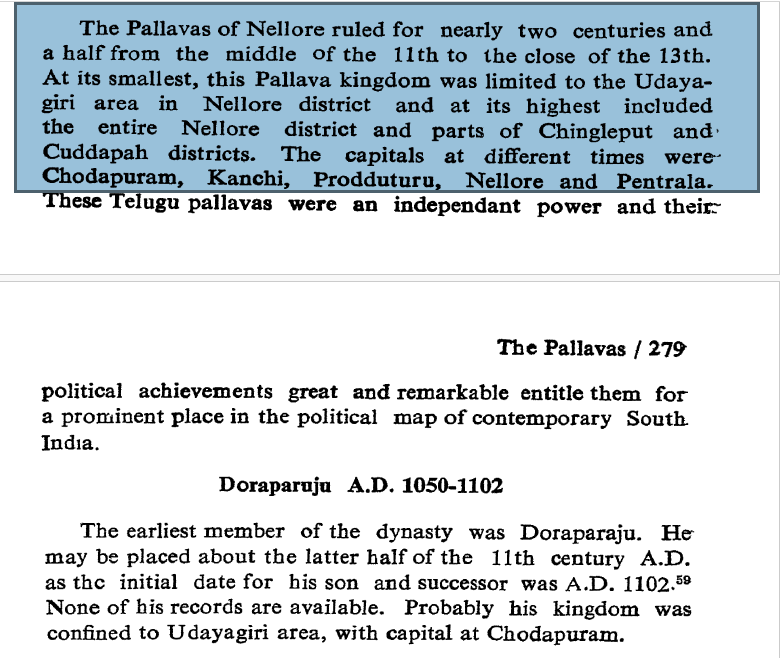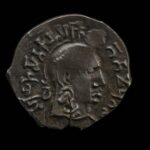
Our Series on Andhra History continues with the next installment on the Pallava Dynasty.
Introduction
Regionalism has been stoked for the past century so as to occlude the true heritage of the Andhras, and indeed, the Aryas themselves. As Pandith Kota Venkatachalam has asserted, all Vedic Hindus are Aaryas, and Dravidas are merely another tribe of Aaryas. In such an environment, assigning dynasties to different provinces becomes less important than asserting the truth of their provenance. Furthermore, super-imposing casteism onto the interpretations has made this field even more miasmic. To assert history today, even if one is well-meaning and as non-biased as a human can be, is to risk public discord or worse.
Yet, the truth bows to no one; indeed, it is we (regardless of caste) who must bow to truth. Without truth, neither is harmony possible nor even the correct lessons of history accessible. If no one is ever at fault, then leaders are never to blame. If leaders are never to blame, then no one is ever accountable—and that, more than anything else, more than any society or civilization itself, is the problem with Hindu society today. Those entrusted with the truth have corrupted it, those responsible for defending the truth, mock it. History itself has become a battlefield of asserting legitimacy (howsoever illegitimate) to power. And that is the bitter reality of historiography today. And all this took place before the first coloniser even set foot upon the hallowed shores of Bhaarathavarsha. It is true, there is much blame to lay upon their heads, but at some point, one must introspect, and ask, “Well, were we doing what we were supposed to do?”. That is not only the sign of a dhaarmika, but also the sign of real men. Whither are they today?
The Pallava dynasty stands at the confluence of this question. One of the most southerly of dynasties has somehow been assignated a foreign origin purely on the specious basis of “cognates”.
The etymology of the Pallava dynasty has been up for debate for far too long. Puranic history clearly establishes their origin from the Andhra Satavahana dynasty. What is left, of course, is the name itself. The ongoing attempt at the persianisation of Bhaaratheeya Samskrthi has resulted in such abominations as referring to Buddha as “Saka-muni” rather than ‘Saakya-muni”. Similarly, it was not the Pahlava (Parthian) dynasty but Pallava dynasty.
Raajyavrkshasya nrpathimoolam skandhaascha-manthrinaah |
Shaakhaah senaadhipaah senaah pallavaah kusumaani cha |
Prajaah phalaani bhoobhaagaa beejam bhoomih prakalpithaa ||
“The king is the root of the tree of state; the ministry is its trunk; the military chiefs are branches; the army are the leaves of the tree and the subjects are its flowers; prosperity of the country is its fruits and the whole country the final seed.” [5, 30]

Understandably, there are some Tamilians who might be distraught that this dynasty which dominated Tamilakam might not be Tamil after all; however, the Chola dynasty hailed from the Chola desam (which is an undisputed Tamil-borderland). Ergo, regionalism should be set aside when in search of the truth—and Tamil dynasties such as the Cholas, Cheras, and Pandyas should be recognised as such.
Now that the etymology is out of the way, the native origin and basis can now be adumbrated. Although caste is a malignant topic in this day and age, clarification around the varna of a dynasty or personality can ensure that that native Indic origin can be re-asserted.
Pallava Cheta [Chutu] Sena Kadamba Rashtrakuta Vishnukundina Brihatpalayana Baana Ganga Hosala[Hoysala?] Rajaputra Salankayana Vakataka Vallabhi [Maitraka?] Vardamba Nolamba . [6, 144]
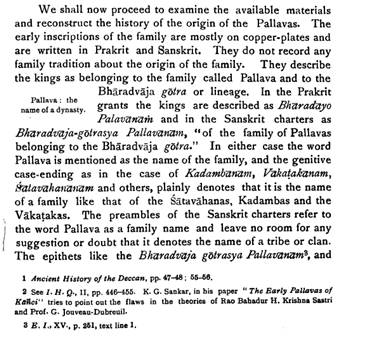
“The viceroys under the last Satavahana king married his daughter to Virakurcha Varma, the founder of the Pallava dynasty. Virakucha Varma inherited the southernmost kingdom from his father-in-law and extended it northwards and westwards.”
Asmaka (again…)
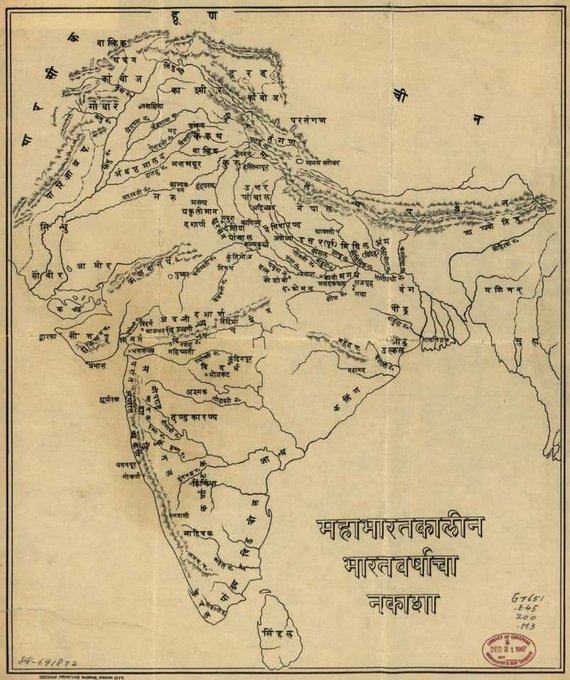
Having clarified the provenance of the Pallavas, an historical tangent of a neighbouring province is also in order. We have attempted to soothe the feelings of our Tamilian friends to the South by clarifying the Chola desa origins of the Chola vamsa. Now, let us further mollify the Maharashtrian people.
While the Marathi people have a storied history in the medieval era, their ancient origins have been a matter of recent debate. Part of it is due to Maharashtra’s place as the first desa in Dakshinapatha, and as a crossroads of North and South (North thinks they are South and vice-versa), but also because history has been tampered with of late.
This reiterates the dangers of speculation as there was both a northern Potana and southern Potana. In fact the Jain writer Vimalasuri takes the name Potanapura as a synonym for Takshasila (Taxila), as Kusumapura was a synonym for Paataliputra.

Cartographical aggression is not unknown in the post-modern era. However, sometimes it occurs sub rosa. In recent years, the 16 Mahajanapaadhas have seen some circulation around to different regions to suit the agendas of modern politicians (many of them videshi with videshi agendas). However, none stands more obvious that Asmaka desa, and its ever-so-incremental inching to the east. Its central import to the Marathi identity cannot be gainsaid and should not be surrendered to neophyte political formations.
Spelling is a contentious issue, particularly with non-abugida languages. The capital of Asmaka/Assaka was Pratishtaana, as the city of Bodhan/Potana/Podana was on the edge of the kingdom and unfit to be the capital for most of its history. Here is the map.
As mentioned previously, compradors of colonisers have been inventing new identities. Those who rejected the pauranic association of Aandhra with Telugu now are rejecting Telugu itself for an apparent “Telangana bhaasha”. One can only presume what bhaasha they call it next… “telangi bedangi”? Such shameless people do a disservice to the land of such greats as Pothana Mahakavi and Mallinatha.
Naysayers argue saying that Potali/Potanapura of Buddhist times must certainly have been Bodhan in modern Telangana—but it just as easily could have been the Pali corruption of Pratishtaana (just like the Buddhists called Asmaka as “Assaka” or Nirvaana as Nibbaana). Pratishtaana (that is Paithan in Maharashtra) was the historical capital of the Asmakas. That Aandhras such as Satakarni later conquered and ruled it does not change that fact.
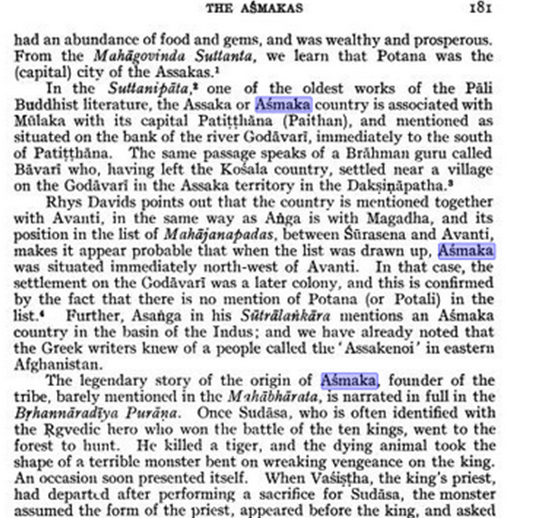
The location of Asmaka in the “UPPER Godavari valley” (meaning Maharashtra proper) is again emphasised here, even whilst accounting for Buddhist sources.
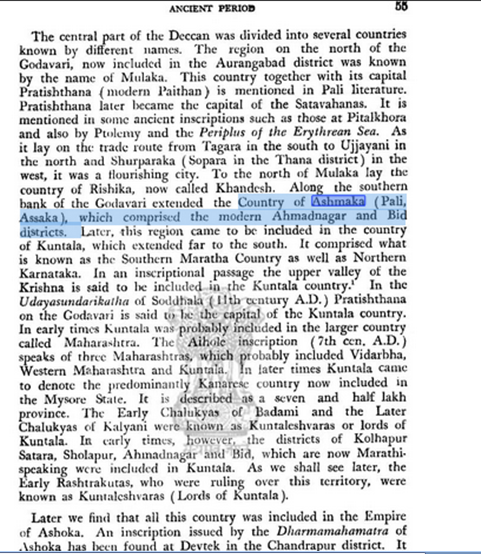
To base an whole identity around modern speculation about merely the city of “Potana/Podana” is poor scholarship and smacks of agenda to further transform the Telugu culture of the brave people of Telangana back to medieval-colonial“telangi bedangi”. The simple fact that during the Sayudha Poratam the Hyderabad state Telugu association was called “nizam ANDHRA Mahasabha”, goes to show what was actually the ancient name of Telugu-land , before foreigners and persianised parvenus began arriving. Records going back to the ancient period only refer to the Aandhras and “their sweet language”, rather than the medieval invention of “Telingana”.
The new state of Telangana has every right to its own distinctiveness, native culture, and political agency within the Indian Union…
….but no one has the right to corrupt history in order to justify a new colonial nizami identity. The Jatakas themselves are useful for background but are comparatively inconsistent sources of history, unlike the Puraanas and the Mahabhaaratha. As noted in the Jain Gazette of 1925, the location of Podana itself was not known for certain. On that specious basis, subsequent speculation has occurred to connect the entirety of Telugu land to a region and name other than Aandhra (the Sanskritic name for the region dating back to before the Mahabhaaratha).
Rather than a committee of “peers” (confederacy of dunces?) it is important to rely on traditional astika pandits who are competent to actually interpret the meaning of pauranic texts. As Pandith Chelam asserted, Aandhra=Telugu, ergo Asmaka must mean Maharashtra.
Just because a dynasty originates in a different desa, however, does not mean the desa loses all claim over the dynasty or polity. Just as the Asmakas originate in the north, but belong to Maharashtra, so too are the Pallavas shared by both Telugus and Tamilians alike.
Vamsa Vrksha (Genealogy)
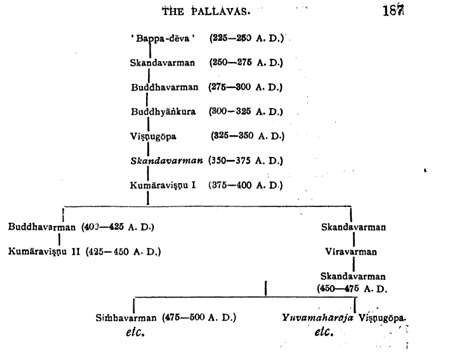
“Attempts have been made to arrange them in chronological and genealogical order, though no theory has been met with general acceptance. In general they may be placed between the fourth and sixth centuries A.D. Vishnugopa of Kaanchee, defeated by Samudragupta, was certainly a Pallava ruler of this time.” [4, 393]
The quandary of Pauranic history versus Western Chronology leads us to alternating between 300 BCE and 300 CE for the rise of this royal house.
“Pallava history opens with three copper-plate grants, all in Praakrit and all dating from the time of Skandavarman, the earliest when he was yuvaraaja, the others after he had become king. He belonged to the Bhaaradvaaja gotra, performed the agnishtoma, vaajapeya and asvamedha sacrifices and bore the title ‘Supreme King of Kings devoted to dharma’. In his time Kaanchipuram was the capital and his kingdom extended up to the Krishna in the north and the Arabian Sea in the west.” [2, 91]
Simhavarman
The inscriptions of the Imperial Pallavas start with the early Pallavas at Nashik (in Prakrit), followed by Sanskrit for the Imperial Pallavas, and mostly Tamil for the later Pallavas. Regardless, they would dominate the Chola desam until the Imperial Cholas themselves would overthrow them. The first among the prominent kings was Simhavarman.
“Simhavarman, a Pallava king, is described as kaliyuga-dosavasanna-dharmoddharana-sannadha, i.e. keenly engaged in salvaging the dharma beset beset by the evils of the Kali age. Several kings are described as engaged in the maintenance of the varna system.” [3, 191]
Simhavishnu
“Simhavishnu was the son of Simhavarman one of whose copper-plate grants dated in the sixth year of his reign as turned up recently; it records a grant to a Jaina institution…So we may consider Simhavishnu the virtual founder of the Pallava power in this period.” [2, 135] He overthrew the Telugu-cholas and crushed the Kalabhras. He was considered to be a Vaishnavite.
His son, Mahendravarma I, had titles such as Mattavilaasa, Vicitra-citta and Gunabhara. “He was a great builder, a poet and a musician. He professed Jainism for a time but discarded it in favour of Saivism, possibly under the influence of Appar.” [2, 135]
Unfortunately for Mahendravarman, he is said to have been defeated by a then rising Pulakesin II. This shaved off the northern provinces of the Pallava dominion. He is credited with writing Sanskrit farces and commencing the practice of single rock-cut temples. [4, 393]
The Pallavas would have an impact not only in expanding their own dynastic legacy, but also by giving rise to altogether new ones. Kunthala desa would have a prominent place in the story of this dynasty and contribution.
“The Kadambas claim to have migrated from North India but seem to be an indigenous dynasty of Kuntala (North Kanara District). A very early inscription gives an interesting account of the origin of this royal dynasty. It is said that Mayurasarman, a learned Brahmana, who had gone to Kanchi for study, was insulted by a Pallava official. Burning for revenge he took to military profession, defeated the frontier-guards of the Pallavas, and conquered some territories.
Ultimately he came to terms with the Pallavas and, in return for loyal services, obtained a feudal principality on the western coast. There may be some truth in this, and Mayurasarman probably ruled in the third quarter of the fourth century A.D. It is not unlikely that the political confusion caused by Samudragupta’s invasion enabled him to set up an independent kingdom with its capital at Banavasi. His son and successor Kangarvarman changed the family title from Sarman to Varman and assumed the title Dharmamaharaja-dhiraja…His grandson Kakustha-varman (c.430-450 A.D.) seems to have been a powerful king, and he claims to have made many marriage alliances with the Guptas and other kings.” [4, 401]
Narasimhavarman I
One of the great names in the history of the Pallavas was Narasimhavarman I. Chalukya Pulakesin II distinguished himself in battle with the great Harshavardhana. However, it appear he styled himself dakshinapatha-pathi too soon and was worsted in war further south.
He commenced his attack on a Pallava feudatory. “After overrunning their kingdom [the Baanas] he invaded the Pallava territory proper and once more threatened the capital. But Narasimhavarman defeated the Chaalukyas in several battles included one at Manimagala about 20 miles to the east of Kaanchipuram. In these battles Narasimha was ably assisted by a Ceylonese. Pulakesin’s expedition was thus a failure and was soon followed by terrible retribution. Narasimhavarman, encouraged by his successes, invaded the Chaalukya country in force and, rapidly advancing to the capital, Baadaami, made himself mater of the city and its fortress.Pulakesin II must have fallen fighting, and following upon his death his kingdom was threatened with disruption.” [2, 137]
The Eastern Ganga king was the maternal grandfather of Chaalukya Vikramaditya (one of the claimants to the Baadaami throne), and he assisted in forcing the Pallavas to retire. Narasimhavarman I had plenty of reason to be satisfied, however. Not only had he ably defended his empire, but had chased and punished the invader back to the latter’s capital. “He then proclaimed himself king of the restored kingdom in 654-5 and rewarded his younger brother Jayasimhavarman, who had stood by him all along, with the viceroyalty of Laata or southern Gujarat”. [2, 137] Narasimhavarman would also shelter the Sinhalese prince Maanavarman, and would send 2 naval expeditions to place him on the throne there. Narasimhavarman would be considered the most powerful ruler of Southern India.
There are said to have been 3 peaks to the Pallava dynasty, with Narasimhavarman I representing one of them and the greatest after Simhavishnu.
“Narasimhavarman is said to have vanquished the Cholas, Cheras and Kalabhras, as well as the Paandyas, but no details of these battles are known.” [2, 137]
Narasimhavarman I was followed by Mahendravarman II, who was defeated in battle with the Chalukyas. He was followed by Paramesvaravarman I. He defeated the Pandyas and made a raid on Baadhaami. This was followed up by a retreat back to Kanchi where he is said to have decisively defeated Chalukya Vikramaditya. He would would be succeeded by his son Narasimhavarman II.
Narasimhavarman II
Presiding over a peaceful reign, Narasimhavarman II is credited with the Kailasanatha temple of Kanchi, as well numerous paintings, and patronage of Dandin himself. He is reputed to have sent an embassy to the Chinese emperor, who later honoured the Pallava army for the aid it rendered to “chastise the Arabs and the Tibetans.” [4, 397] If the legend of Bodhidharman as kung-fu influencing Pallava prince is true, he would likely have been a contemporary of this king.
Paramesvaravarman II succeeded his father Narasimhavarman II, but would die without issue. He was replaced on the throne by Nandivarman II. This 12 year old boy hailed from a collateral branch of the main Pallava line. He was later known as Pallavamalla and would reign for 65 years. His great general Udayachandra would defeat the Pandyas and Nishaadhas at his behest. Eventually, the Pandyas would defeat Nandivarman’s alliance with Kerala and Kongu.
He was succeeded by Dantivarman (c.796-840 A.D.), who would also suffer reverses at the behest of both the Pandyas and the Rashtrakutas. Nandivarman III would have better success, and eventually defeated the Pandyas. [4, 397]
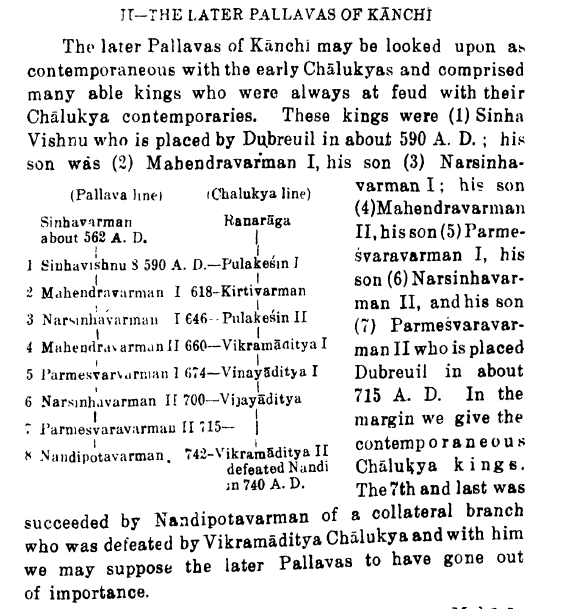
“Aditya I, however, did not rest content with a subordinate position. He planned and carried out the overthrow of the effete power of his suzerain. He invaded Tondaimandalam, and in a battle that ensued he pounced upon Aparaajita when he was mounted on an elephant and slew him. That was the end of Pallava rule in Tondainaad, and the whole of the Pallava kingdom now became Chola territory” [2, 159]
The Imperial Pallava dynasty (at least in Tamil regions) came to a rather violent end. The see-saw of power between the Pallavas and Cholas reached their apogee and conclusion in the form of Aditya I and Pallava Aparajita:
“For a period of 300 years from the middle of the sixth century A.D., the history of South India is virtually the story of mutual conflict among three powers each seeking constantly to extend its empire at the expense of its neighbours. The three powers were the Chaalukyas of Baadaami, the Pallavas of Kaanchi and the Paandyas of Madura.” [2, 133]
This period saw a Hindu (mainly Saivite) revival in regions that were previously dominated by Buddhism and Jainism.
Later Telugu Pallavas
There is some discrepancy as to whether the Pallavas were extinguished or continued for a lengthy period as feudatories of the Eastern Chalukyas. Evidence indicates the latter. They are colloquially referred to as the Telugu Pallavas, though they along with the Imperial Pallavas would have an Aandhra origin. They are, perhaps, better referred to as the “Later Pallavas”.
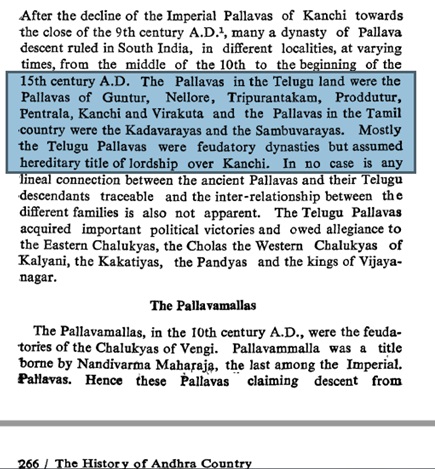
What is notable, however, is that they feature at Gonturu (Guntur), Pentrala, and Nellore. Regardless, it can be deemed one more exhibit of evidence in evincing the Aandhra character of this dynasty. As further evidence that the medieval Later Pallavas do indeed originate from the ancient Imperial Pallavas, one can take note of the name Pallavamalla.
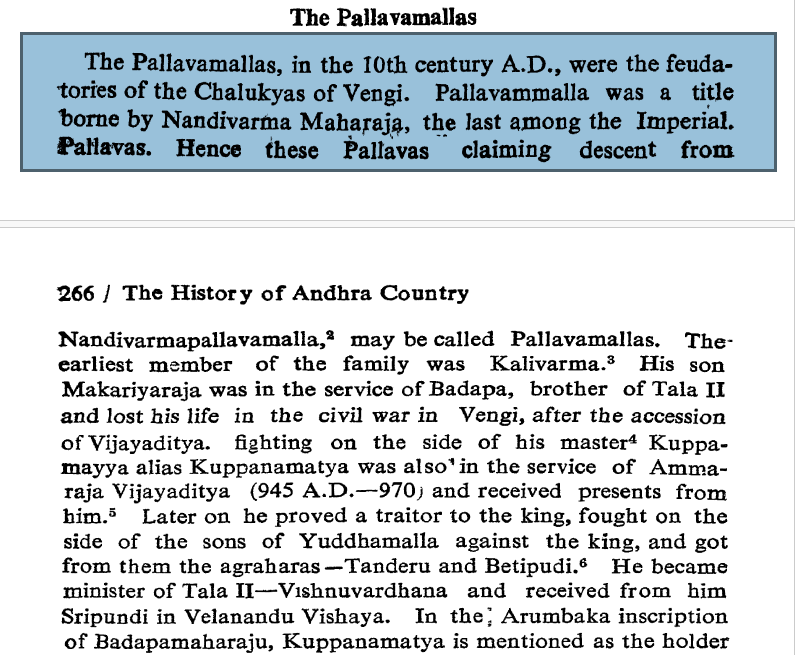
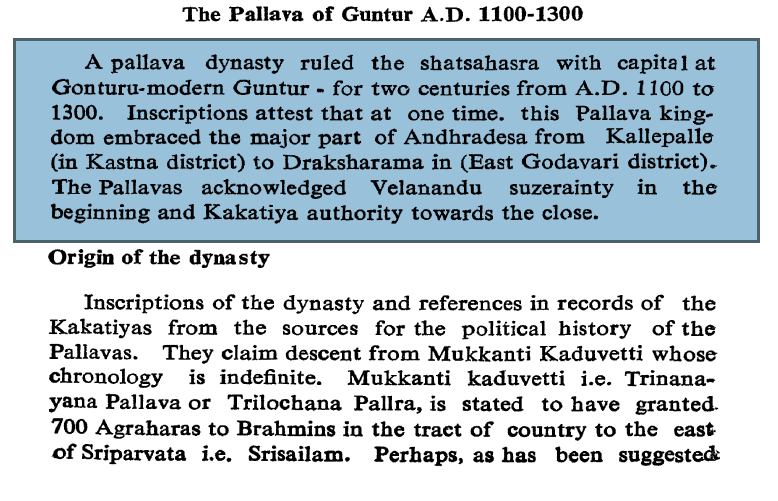
Next up were the Pallavas of Nellore, who ruled frm 1050-1300 CE.
Better known then as Vikrama-simhapuri, Nellore featured one of the last remaining independent Pallava kings. This was a distinct achievement in a period where they would have been triple-decker sandwiched between the Cholas, Chalukyas, and Kakatiyas. Indeed, they presided over the old crownlands of the Imperial Pallavas, in and around Udayagiri. The Kings were Doparaju, Yamaraju/Nandivarma, Aluntirukalatti/Allutikka, Bheemaraja, Inumadideva, Veeragandagopala (independent). The dynasty would then be subordinated by the Pandyas, and continued until Vijayagandagopala and his son Veeragandagopala II. [12, 295]
The Veeragandagopala I had a close relationship with the Kakatiyas. Interestingly, the Great Kakatiya kings were actually known as “Andhreshwara”, and as stated previously, Warangal was known as “Andhranagara”. This is further proof that much of the politicisation of Telugu history has resulted in artificial distinction between Telangana and Andhra Pradesh states—in the past both states would have been part of ancient and medieval “Andhra desa” only.
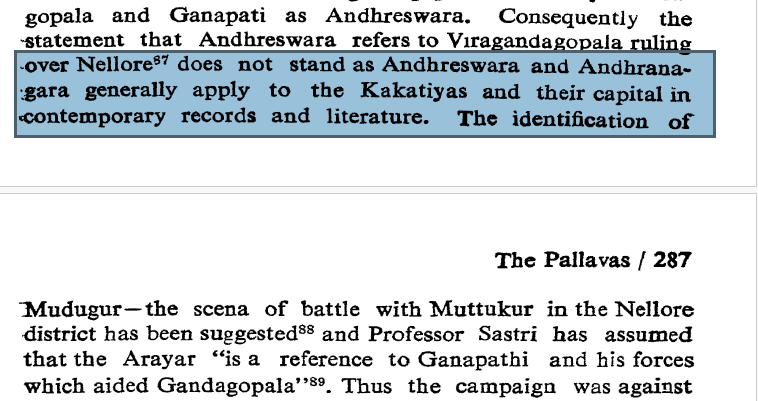

Administration

The empire itself at its peak was said to extend from the Laata country in Southern Gujarat to deep into Tamil Nadu (with Southern Aandhra in between). Despite being an absolute monarchy, it was not a tyranny. Kings were expected to govern under the auspices of Dharma (which was supreme). The influence of both Vaidika braahmanas and Bauddha Acharyas would have been significant.
The Pallava administration functioned very much like its Satavahana predecessor. Indeed, it is said to have taken inspiration from it. Its dhvaja was the Khatvanga and its lanchana was the Bull.
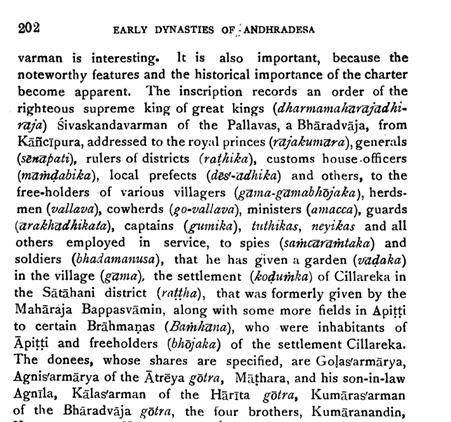 There were a number of prominent Queens as well. Though none appear to have been independently ruling, Maharani Charudevi of the Pallava house recorded an edict. She was the wife of the Yuvaraaja Sri Vijaya-Buddhavarman, and the mother of prince Buddhyankura. [11, 175]
There were a number of prominent Queens as well. Though none appear to have been independently ruling, Maharani Charudevi of the Pallava house recorded an edict. She was the wife of the Yuvaraaja Sri Vijaya-Buddhavarman, and the mother of prince Buddhyankura. [11, 175]
Cultural Contribution of the Pallavas

Somaskanda Panel, Panamalai, Pallava Dynasty
The Kailasanatha temple at Kanchi is of great antiquity. This rock-cut structure is attributed to the Pallava King Rajasimha, who was assisted in this artistic endeavour by his Queen Rangapataka.
“The paintings in the monuments of this king give us splendid examples, though not many, of the Pallava phase of painting” [13, 52]

Parvati, Panamalai. Pallava Period
Panamalai (with an exquisite Parvati mural) also provides us with lovely examples of this artistic phase. Fading though they are, these murals nevertheless, are superbly designed. They give glimpses into the level of mastery that must of have been reached by ancient Bhaaratheeyas. With an identifiable style of line and colour in cave temples, such as the one at Mamandur, these successors to the Satavahanas made their mark on the art of Tamil Nadu.
Architecture
It is in architecture, however, that we see the most prominent contribution of the Pallavas. “The earliest examples of the Dravidian style are the rock-cut temple known as Dharmaraaja-ratha at Maamallapuram and the structural temples at Kaanchee, known as the Kailaasanatha and the Vaikuntha Perumal,—all built by the Pallava kings. The first is a monolithic structure which, along with six others on the same site, are known as the seven rathas or Pagodas, and show the ingenuity of Pallava artists.” [4, 464]
The Bhakti Movement
“The origins of the bhakti movement with its emphasis on devotion and appeal to the masses lie first in South India” [1,100]
It is often considered to be a difficult task to trace the exact origin of the Bhakthi movement. Indeed, not only has geography been a question, traditionally, but also whether it can be seen as a phenomenon distinct from “traditional hinduism”. Nevertheless, conventional scholarship asserts as much, and the Pallavas are credited with a role here too.
“The beginnings of such devotional singing were found in Tamil Nadu, where a number of such saints arose between the fourth and ninth centuries CE. They traveled on foot from village to village, town to town, temple to temple, singing such philosophical songs in simple language of the masses. From the Pallava country, the devotional, or bhakti, movement was carried to South-east asia, where Hinduism and Buddhism were spreading rapidly among the common people. The saints of Siva, known as Nayanars, called the devotional hymns Devaram, and the saints of Vishnu, known as Alvars, called their hymns the Divya Prabandham.” [1, 101]
Indeed, the Pallavas can be credited with true sampradhaayic syncretism. They gave patronage to Saivites, Vaishnavites, Bauddhas, and Jainas alike. Many of the more competitive episodes seem more likely to have taken place during the more iconoclastic Chola and Pandya periods. Pallavas, in contrast, seemed to embody Bhakthi.
“The saintly, devotional bhakti tradition was in full bloom in the eighth and ninth centuries CE, continued thereafter, and has remained alive and popular to this date in Tamil Nadu. Tamil bhakti saints such as Jnana-sambandha and Tirunavukkarashu (both in the seventh century CE) and Manik-kavaschakar (born in the eighth century) were popular and effective in keeping the followers of the Sanatana Dharma within the Hindu fold. The first of them helped to reconvert the Pallava ruler, Mahendra Varman’s sister, Tilakavati, from Jainism to the worship of Siva; a similar reconversion of the Pandya king of the time from Jainism to the worship of Siva is attributed to the second saint.” [1, 101]
Bharavi was the friend of a Western Ganga prince named Durvinita, and was later a poet in the court of the Pallava ruler Simhavishnu at Kanchi…Indeed, the ghatikas at“Kanchi and Bahur (near Pondicherry) in South India, were patronized among others by the Pallava kings.” [2, 112].
Conclusion

The Stamp of the Pallavas is indelible, not only on Aandhra, and India, but that Greater India known as the Indosphere, and even Asia itself. From Mahabalipuram to China to Champa and back, the Pallavas (like the Satavahanas before them) were simultaneously Brahminical and Buddhist. Where many see and seek conflict, one might often find harmony. It is only those lusting for power who would seek to put Dharmic sampradhaayas at loggerheads. As mentioned a plethora of times previous, the true conflict within Indic Civilization is not between Vaidika and Jina or Brahminical and Bauddha or Hindu and Sikh, but between Astika Vaidikas and Casteist Kapaalikas.
Varna was most assuredly by birth, but also filtered by Guna and Karma. Jaathivaadha is literally race-theory; hence its espousal by “raceist-casteists” (not our phrase) who would seek alliance with foreign races for the detriment of not only Bhaaratheeyas, but the only real race, the human race. The mistake many non-kshathriya Bhaaratheeya ruling dynasties made was not properly initiating as Kshathriyas once the dynasty was formally coronated and recognised. Even among those that did, they often preferred inscribing a more Vedic Kshathriya lineage rather than content themselves with their true origins.
The Pallava “Varmans” made some attempt at this, as did Mayurasarman of the Kadambas. But if Bheeshma Pitamaha’s corollary for the Kali Yuga is to be followed, then provision must be made for power vacuums to be vedically filled—lest videshis seek to do the same (as was clearly attempted with the etymology of the Pallavas). Endogamy or not, ethnicity is real. It is time for those jaathivaadha-obsessed janatha/ethnic-drohis to be held to account.

References:
- Sardesai, D.R. India: The Definitive History. Boulder: Westview Press. 2008
- Sastri, K.A.Nilakantha. A History of South India. New Delhi: Oxford. 2015
- Sharma,R.S.Aspects of Political Ideas.
- Majumdar,R.C.Ancient India. MLBD: Dehli.2003
- Jayaswal, K.P. An Imperial History of India. Lahore: MLBD. 1934
- Kota, Venkatachalam Paakayaaji (Pandith). Chronology of Ancient Hindu History Part I. Vijayawada: AVG.
- Vaidya, C.V. History of Medieaval Hindu India. New Delhi: Cosmo Publications.1924
- Law, Bimala Churn. Tribes in Ancient India. Poona: Bhandarkar. 1943
- The Jaina Gazetter. Madras: Oriental Conference. 1924
- Maharashtra State Gazetteers: Bhandara District. Bombay: Govt of Maharashtra. 1979
- Bhavaraju, Venkata Krishna Rao. A History of the Early Dynasties of Andhra Desa (c. 250-625 A.D). Madras: V.Ramaswami Sastrulu & Sons. 1942
- Devi, Yashoda. History of the Andhra Country 1000-1500, vol i. New Delhi: Gyan Publ. 1993
- Sivamurti, C. Indian Painting. New Delhi: National Book Trust.2013

